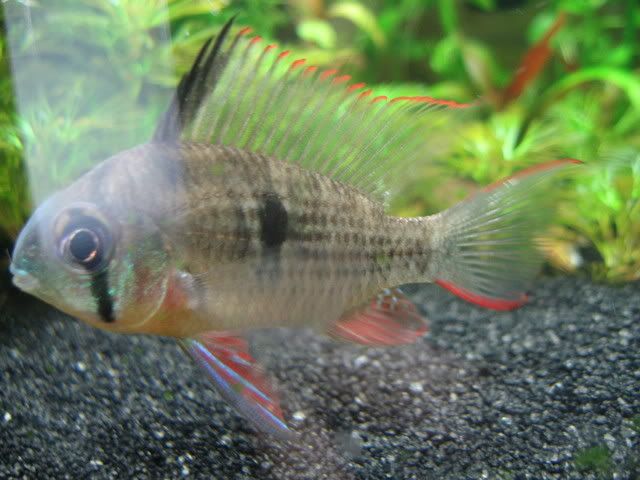can anyone sex this bolivian ram?
- Thread starter dbleoh7
- Start date
the temp is at 79*F. he seems very happy with the temp.
thanks katie, i have no idea if it's a nice bolivian ram or a crappy one since i'm new at this fish game. i can't find too many pics online to compare *it* to. when i got it i just picked the most aggressive out of about 20 thinking this means that it's probably very fit and will show good color!? that could be bogus logic. who knows.
so, is it a male...........or female? any more opinions?
thanks katie, i have no idea if it's a nice bolivian ram or a crappy one since i'm new at this fish game. i can't find too many pics online to compare *it* to. when i got it i just picked the most aggressive out of about 20 thinking this means that it's probably very fit and will show good color!? that could be bogus logic. who knows.
so, is it a male...........or female? any more opinions?
could just be young, but it kinda looks mature. At first my male didnt have the tail ray extensions but he's got long ones now(until the female nips them off). take a look at the post in the middle of the page.
http://www.cichlid-forum.com/phpBB/viewtopic.php?t=137945
http://www.cichlid-forum.com/phpBB/viewtopic.php?t=137945
ditto cichlid-man. The males 2 front barbs on the dorsal fin are black like yours females have pink bellys.
Females of M. altispinosa do not develop pink bellies.
The extensions of the caudal fin is subjective. Poor water quality can hinder growth of decent extensions, they can be bitten off by other fish and females can develop them as well.
There is no accurate way of sexing M. altispinosa by observation of superficial characteristics such as color, pattern or fin length/coloration, especially in young fish and even more so when you only have one instead of several to compare to one another.
If I had to guess I'd say male for the length of ventral fins, the height of the dorsal and shape of the belly, which is flat.
But, the only accurate way of sexing M. altispinosa would be to observe the genitalia. This can be done easily enough if you know what to look for.
Sometimes all it takes is a really good feed to make the breeding tubes a little more obvious and easier to identify.
In males the tube will taper to a point and lean toward the anal fin.
In females the tube is thick and cylindrical, usually points straight down.
You can see perfect examples of this here.
The fish looks a little uncomfortable with his surroundings yet, this is common with newer fish who have not yet fully established themselves in their new home or spooked fish.
Healthy Bolivians can take temperatures higher or lower than their ideal range very well, without exhibiting such stress coloration.
All he needs is a little time to let him feel like the kind of his castle and he'll be a gussied up iridescent prince in no time


